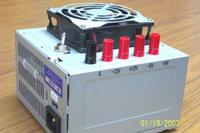1. What is a coaxial cable?A. Two wires side-by-side in a plastic ribbon
B. Two wires side-by-side held apart by insulating rods
C. Two wires twisted around each other in a spiral
D. A center wire inside an insulating material covered by a
metal sleeve or shield
2. A mobile radio may be operated at home with the
addition of which piece of equipment?A. An alternator
B. A power supply
C. A linear amplifier
D. A rhombic antenna
3. What may cause a buzzing or hum in the signal of an
HF transmitter?A. Using an antenna that is the wrong length
B. Energy from another transmitter
C. Bad design of the transmitter's RF power output circuit
D. A bad filter capacitor in the transmitter's power supply
4. What is the amateur station activity known as fox hunting?A. Attempting to locate a hidden transmitter by using receivers
and direction-finding techniques
B. Attempting to locate a hidden receiver by using receivers
and direction-finding techniques
C. Assisting government agents with tracking transmitter
collars worn by foxes
D. Assembling stations using generators and portable antennas
to test emergency communications skills
5. If you answer someone on the air and then complete your
communication without giving your call sign, what type of
communication have you just conducted?A. Test transmission
B. Tactical signal
C. Packet communication
D. Unidentified communication
6. How many watts of electrical power are used by a 12-VDC
light bulb that draws 0.2 amperes?A. 60 watts
B. 24 watts
C. 6 watts
D. 2.4 watts
7. What are the receiving and retransmitting frequency
bands used for Mode V/U in amateur satellite operations?A. Satellite receiving on 435 to 438 MHz and
retransmitting on 144 to 148 MHz
B. Satellite receiving on 144 to 148 MHz and
retransmitting on Amateur bands in the range of 21 to 30 MHz
C. Satellite receiving on 144 to 148 MHz and retransmitting
on 435 to 438 MHz
D. Satellite receiving on 435 to 438 MHz and transmitting
on 21 to 30 MHz
8. How fast does a radio wave travel through space (in a vacuum)?A. At the speed of light
B. At the speed of sound
C. Its speed is inversely proportional to its wavelength
D. Its speed increases as the frequency increases
9. What must you transmit to identify your amateur station?A. Your "handle"
B. Your call sign
C. Your first name and your location
D. Your full name
10. Which of the following one-way communications may
NOT be transmitted in the amateur service?A. Telecommand to model craft
B. Broadcasts intended for reception by the general public
C. Brief transmissions to make adjustments to the station
D. Morse code practice
11. What do RTTY, Morse code, AMTOR and packet
communications have in common?A. They are multipath communications
B. They are digital communications
C. They are analog communications
D. They are only for emergency communications
12. Depending on the wavelength of the signal,
the energy density of the RF field, and other factors,
in what way can RF energy affect body tissue?A. It heats body tissue
B. It causes radiation poisoning
C. It causes the blood count to reach a dangerously low level
D. It cools body tissue
13. What is the correct way to call CQ when using voice?A. Say "CQ" once, followed by "this is," followed by your call
sign spoken three times
B. Say "CQ" at least five times, followed by "this is,"
followed by your call sign spoken once
C. Say "CQ" three times, followed by "this is," followed by
your call sign spoken three times
D. Say "CQ" at least ten times, followed by "this is,"
followed by your call sign spoken once
14. Where should you connect the chassis of each piece
of your station equipment to best protect against
electrical shock?
A. To insulated shock mounts
B. To the antenna
C. To a good ground connection
D. To a circuit breaker
15. What instrument is used to measure standing wave ratio?A. An ohmmeter
B. An ammeter
C. An SWR meter
D. A current bridge
16. If signals from your transmitter are causing front-end
overload in your neighbor's television receiver, who is
responsible for taking care of the interference?A. You alone are responsible, since your transmitter is
causing the problem
B. Both you and the owner of the television receiver
share the responsibility
C. The FCC must decide if you or the owner of the
television receiver are responsible
D. The owner of the television receiver is responsible
17. What formula shows how voltage, current and
resistance relate to each other in an electric circuit?A. Ohm's Law
B. Kirchhoff's Law
C. Ampere's Law
D. Tesla's Law
18. In what direction does a vertical antenna send out
radio energy?A. Most of it goes in two opposite directions
B. Most of it goes high into the air
C. Most of it goes equally in all horizontal directions
D. Most of it goes in one direction
19. What item of test equipment contains
horizontal- and vertical-channel amplifiers?A. An ohmmeter
B. A signal generator
C. An ammeter
D. An oscilloscope
20. What determines the free-space polarization of an antenna?A. The orientation of its magnetic field (H Field)
B. The orientation of its free-space characteristic impedance
C. The orientation of its electric field (E Field)
D. Its elevation pattern
Adopted from e-ham question bank


